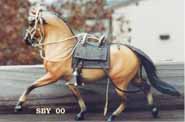 Outside of McClellans and 1 Arab costume, I'd never made a saddle with a tree. A Portuguese Bullfighting saddle I made in 1997 was helpful, but even so, a notebookful of Peruvian reference was not enough. Eighty-plus hours of experimentation went into it, including a fabulous idea for a leather-encased metal core to give the saddle weight and strength. This piece of tack has given rise to the greatest compliment a modeller can recieve: Peruvian Paso people have taken it for the real thing. ;)
Outside of McClellans and 1 Arab costume, I'd never made a saddle with a tree. A Portuguese Bullfighting saddle I made in 1997 was helpful, but even so, a notebookful of Peruvian reference was not enough. Eighty-plus hours of experimentation went into it, including a fabulous idea for a leather-encased metal core to give the saddle weight and strength. This piece of tack has given rise to the greatest compliment a modeller can recieve: Peruvian Paso people have taken it for the real thing. ;)
|
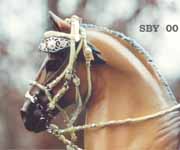 A close-up of Buckler's 'Raven' wearing my first full Peruvian Paso set. At the time, in 2000, I had no other Peruvian model, so 'Raven' was on the spot! Doing this tack aroused a deep admiration for the Peruvian method of handling a horse. There are four places where the headgear adjusts. The tapa ojos have to be tied in a figure-8 knot by hand---that is the strap hanging down with the metal tip. The gamarilla, or nose plate, is used to raise and position the bit in the horse's mouth. Fancy ones are chased and hinged. I couldn't manage a hinge.
A close-up of Buckler's 'Raven' wearing my first full Peruvian Paso set. At the time, in 2000, I had no other Peruvian model, so 'Raven' was on the spot! Doing this tack aroused a deep admiration for the Peruvian method of handling a horse. There are four places where the headgear adjusts. The tapa ojos have to be tied in a figure-8 knot by hand---that is the strap hanging down with the metal tip. The gamarilla, or nose plate, is used to raise and position the bit in the horse's mouth. Fancy ones are chased and hinged. I couldn't manage a hinge.
|
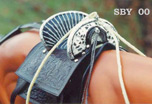 The saddle viewed on an angle from the front. In real life, such sterling-silver filigree is expensive, rare and almost too flashy. (Almost a command to us, eh?!) In model, the effect is achieved with silver tape applied to leather, then cut out. This shot also shows my earliest binding effort. Again, I turned to silver tape. It successfully depicts the solid-metal real-life binding; however, I worry about the adhesive.
The saddle viewed on an angle from the front. In real life, such sterling-silver filigree is expensive, rare and almost too flashy. (Almost a command to us, eh?!) In model, the effect is achieved with silver tape applied to leather, then cut out. This shot also shows my earliest binding effort. Again, I turned to silver tape. It successfully depicts the solid-metal real-life binding; however, I worry about the adhesive.
|
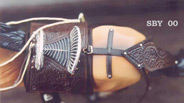 Bird's eye view of the elaborate seat stitching of Set No.1. That seat was one of those all-too-common cases where the tackmaker tries too hard. Yes, those lines are actual thread stitches, atop a painted background... painted after the stitching was done... evidence of a changed mind. While I can do this sort of exacting work, it is very typical of a pioneering or experimental piece in that it was later dropped. Set No.1 retains its own charm: one of a kind.
Bird's eye view of the elaborate seat stitching of Set No.1. That seat was one of those all-too-common cases where the tackmaker tries too hard. Yes, those lines are actual thread stitches, atop a painted background... painted after the stitching was done... evidence of a changed mind. While I can do this sort of exacting work, it is very typical of a pioneering or experimental piece in that it was later dropped. Set No.1 retains its own charm: one of a kind.
|
|
Click here to go to Timaru Star II Peruvian Paso Sets Page 2, which details P4 and P5, made in 2005.
|
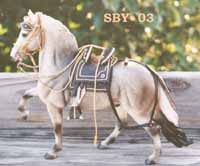 Timaru Star II Peruvian Paso set No.2, now owned by C. Robertson. This set was begun in February of 2003 (before No.3) and was intended to explore the idea of rawhide braidwork as decoration. I was inspired by a real-life saddle seen on Raintree's website. It is quite within character for a Peruvian or, indeed, any Spanish-derived horse breed of the southern latitudes, to ornament himself with braidwork. Although not seen on the original saddle, rosettes on the skirts and tapacola added to the appeal and spread out the impact of the contrasting braid, amoung other things.
Timaru Star II Peruvian Paso set No.2, now owned by C. Robertson. This set was begun in February of 2003 (before No.3) and was intended to explore the idea of rawhide braidwork as decoration. I was inspired by a real-life saddle seen on Raintree's website. It is quite within character for a Peruvian or, indeed, any Spanish-derived horse breed of the southern latitudes, to ornament himself with braidwork. Although not seen on the original saddle, rosettes on the skirts and tapacola added to the appeal and spread out the impact of the contrasting braid, amoung other things.
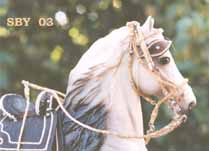 Close up of the headgear of No.2, made for this model, Breyer's Inolvidable (Unforgettable). The bit is a Rio Rondo-- they are the most correct I've found. Over fifty hours of work are in the headgear alone; each button tied on with a needle, tightened with a needle, ends fixed, then trimmed. Then it is dyed with a custom dye; then coated with two different materials for sealing--- drying in between each. On this set I used smooth crimp beads for the silver ferrules. If you remember that the rider has to be able to lower the tapa ojos from the saddle, you will never get mixed up and place them above the browband.
Close up of the headgear of No.2, made for this model, Breyer's Inolvidable (Unforgettable). The bit is a Rio Rondo-- they are the most correct I've found. Over fifty hours of work are in the headgear alone; each button tied on with a needle, tightened with a needle, ends fixed, then trimmed. Then it is dyed with a custom dye; then coated with two different materials for sealing--- drying in between each. On this set I used smooth crimp beads for the silver ferrules. If you remember that the rider has to be able to lower the tapa ojos from the saddle, you will never get mixed up and place them above the browband.
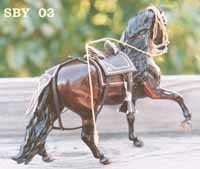 I particularly love this picture. There is something glowing about Sanko as he gaits away-- his color, the swing of the foreleg (called termino), the long loose mane and tail. This pose seems to conceal his faults and celebrate his strengths...! This must have been what Linda had in mind. The retrancas, or breechings, are just long enough: correct is "three inches above the hocks". The stirrups are hung, by rings and straps, so as to be always with the opening to the rear. At first I thought the Rio Rondo-cast stirrups would scratch the horse... but then I learned they are exactly curved to the body.
I particularly love this picture. There is something glowing about Sanko as he gaits away-- his color, the swing of the foreleg (called termino), the long loose mane and tail. This pose seems to conceal his faults and celebrate his strengths...! This must have been what Linda had in mind. The retrancas, or breechings, are just long enough: correct is "three inches above the hocks". The stirrups are hung, by rings and straps, so as to be always with the opening to the rear. At first I thought the Rio Rondo-cast stirrups would scratch the horse... but then I learned they are exactly curved to the body.


 ordinary detail of Peruvian Paso set. No.2. To the sorrow of PhotoWorks (still my favorite image processor), my little ol' scanner has wrought such a change in my photography habits. [Note from the future: we no longer use a scanner once we got the digital, 2005.] For one thing, it's a lot faster! For another, it puts the horse at a disadvantage--although we must always have him, since these pieces are, in the end, in tribute to his beauty. But on the scanner bed, the only thing to see is the tack itself...! which is how I see it! The penny gives scale like nothing else. The tip of the puente (point) is made of genuine rawhide; the sinew romal above it has actually been braided into the rawhide--- the braid started there. Although it looks like a confusion of knots, actually most of the braiding is just two buttons, a large and a small. The buttons occur in repeating groups about a single silver bead. Seeing the pieces of the headgear like this, you can appreciate a little how it all goes together. The tapa ojos (eye covers) go on first; they are beneath everything. The bridle goes on next. Although correctly the gamarilla (metal nose plate) is used only for training, I am so delighted to have something to act as a noseband on these closed-mouth model horses that I enthusiastically include it!! The reins are attached to the bits by swivels, as is the leadrope to the halter
ordinary detail of Peruvian Paso set. No.2. To the sorrow of PhotoWorks (still my favorite image processor), my little ol' scanner has wrought such a change in my photography habits. [Note from the future: we no longer use a scanner once we got the digital, 2005.] For one thing, it's a lot faster! For another, it puts the horse at a disadvantage--although we must always have him, since these pieces are, in the end, in tribute to his beauty. But on the scanner bed, the only thing to see is the tack itself...! which is how I see it! The penny gives scale like nothing else. The tip of the puente (point) is made of genuine rawhide; the sinew romal above it has actually been braided into the rawhide--- the braid started there. Although it looks like a confusion of knots, actually most of the braiding is just two buttons, a large and a small. The buttons occur in repeating groups about a single silver bead. Seeing the pieces of the headgear like this, you can appreciate a little how it all goes together. The tapa ojos (eye covers) go on first; they are beneath everything. The bridle goes on next. Although correctly the gamarilla (metal nose plate) is used only for training, I am so delighted to have something to act as a noseband on these closed-mouth model horses that I enthusiastically include it!! The reins are attached to the bits by swivels, as is the leadrope to the halter  (jacima). The halter fits over everything else; and the loop-and-button on its crown fits over, and encompasses, everything on the poll. Yes, this tack takes the longest to put on... but how much I have learned of another continent's manner of handling the horse.
(jacima). The halter fits over everything else; and the loop-and-button on its crown fits over, and encompasses, everything on the poll. Yes, this tack takes the longest to put on... but how much I have learned of another continent's manner of handling the horse.

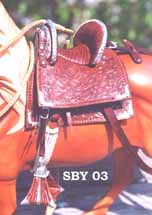
 This is the best way to view No. 3's seat and its carving, the pommel and cantle binding. As before, and also on TSII #422, I found that prepared braided Galaxy silver lacing makes a better binding. The mylar tinsel, which is so effective in other places (like parade), is too thin, and too much of the gold side shows, to work well here, where heavy strength is needed. Such braidwork is quite difficult... this is some of the slowest work I can muster. The odd whitish cast to Chipsy's offside rump is a reflection of some flower pots.
This is the best way to view No. 3's seat and its carving, the pommel and cantle binding. As before, and also on TSII #422, I found that prepared braided Galaxy silver lacing makes a better binding. The mylar tinsel, which is so effective in other places (like parade), is too thin, and too much of the gold side shows, to work well here, where heavy strength is needed. Such braidwork is quite difficult... this is some of the slowest work I can muster. The odd whitish cast to Chipsy's offside rump is a reflection of some flower pots.



